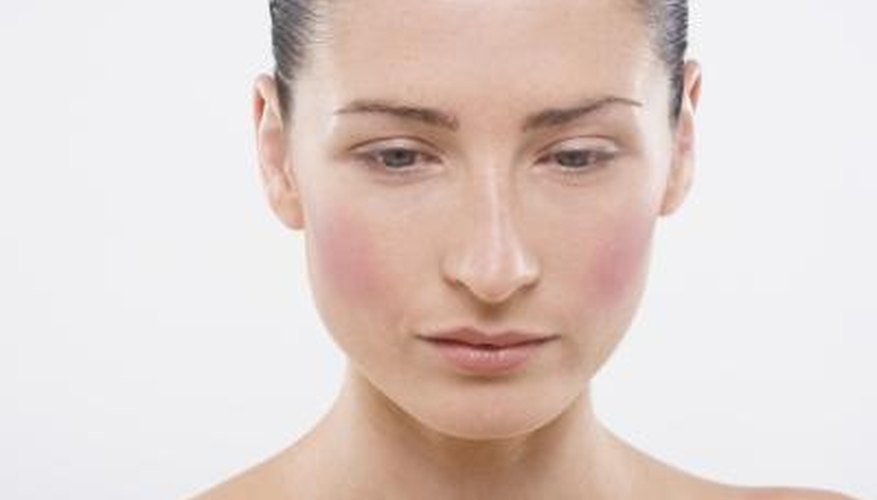Tinea versicolor, also known as pityriasis versicolor, is described by the American Academy of Dermatology as "a superficial fungal disease.” It is a common skin infection that occurs in both men and women and in all climates. The infection often leads to temporary depigmentation of the skin, similar in appearance to vitiligo. Tinea versicolor, however, is not an autoimmune disorder. It is easily treatable and is not normally damaging to your health.
Autoimmune Disorders
The immune system protects one's body from harmful antigens produced by bacteria, viruses, toxins or cancer cells. In people with autoimmune disorders, the immune system functions irregularly and attacks healthy body tissue. This provokes a hypersensitivity reaction, similar to an allergic reaction. What triggers the immune system to turn on the body is unknown. Organs and tissues normally affected by autoimmune disorders include red blood cells, endocrine glands, muscles and skin.
- The immune system protects one's body from harmful antigens produced by bacteria, viruses, toxins or cancer cells.
- In people with autoimmune disorders, the immune system functions irregularly and attacks healthy body tissue.
Autoimmune Disorders Treatment
There are more than 80 different types of autoimmune disorders, including rheumatoid arthritis, lupus, coeliac disease and type 1 diabetes. Given the range of conditions classified as autoimmune disorders, treatment depends on the condition and symptoms. According to Medline Plus, immunosuppressive medicines are often prescribed to control the immune system’s irregular response. Supplements and vitamins may also be prescribed to replenish the body.
- There are more than 80 different types of autoimmune disorders, including rheumatoid arthritis, lupus, coeliac disease and type 1 diabetes.
- According to Medline Plus, immunosuppressive medicines are often prescribed to control the immune system’s irregular response.
Tinea Versicolor
Tinea versicolor is caused by a yeast called malassezia furfur. It is not contagious, and malassezia lives within the body. But some people develop a more aggressive form that invades the skin. The reason for this is unknown. According to the BBC Health website, it is mostly found in teenagers. Oily skin caused by hormonal imbalances during puberty provides a fertile environment for tinea versicolor.
- Tinea versicolor is caused by a yeast called malassezia furfur.
- Oily skin caused by hormonal imbalances during puberty provides a fertile environment for tinea versicolor.
Identification
Tinea versicolor is often characterised by scaly lesions around the chest, back, neck and arms, which can be raised or flat. Lesions on the face are more common in children. “Versicolor” refers to the depigmentation of the skin affected, which range in colours. Most typically, patches will be pink, brown or white. It is often accompanied by mild itchiness.
- Tinea versicolor is often characterised by scaly lesions around the chest, back, neck and arms, which can be raised or flat.
Aggravating Factors
It is unclear what internal factors trigger malassezia furfur to attack the skin in some people. Heat and humidity are known to aggravate tinea versicolor. According to BBC Health website, in some tropical areas more than 40 per cent of the population suffers with tinea versicolor. Excessive sweating, malnutrition and oral contraceptives are other contributing factors. According to the Mayo Clinic website, immunosuppression (when the immune system fails to protect the body from the overgrowth of yeast and fungus) may also worsen tinea versicolor.
- It is unclear what internal factors trigger malassezia furfur to attack the skin in some people.
- According to the Mayo Clinic website, immunosuppression (when the immune system fails to protect the body from the overgrowth of yeast and fungus) may also worsen tinea versicolor.
Treatment
Over-the-counter antifungal skin washes, shampoos, creams and oral medications will effectively treat tinea versicolor. Stronger medication such as selenium sulphide can also be prescribed by a doctor for more severe cases. Treatment will normally clear up the infection quickly but repigmentation of affected skin can take several months. The American Academy of Dermatology recommends using a zinc pyrithione soap between two and three times a week to control recurrence.
- Over-the-counter antifungal skin washes, shampoos, creams and oral medications will effectively treat tinea versicolor.
- The American Academy of Dermatology recommends using a zinc pyrithione soap between two and three times a week to control recurrence.
